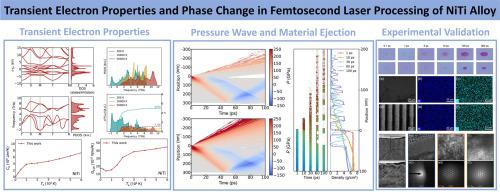飞秒激光加工NiTi合金的瞬态电子特性与相变:多尺度模拟与实验研究
IF 14.3
1区 材料科学
Q1 MATERIALS SCIENCE, MULTIDISCIPLINARY
引用次数: 0
摘要
NiTi合金是一种重要的生物医学材料,飞秒激光处理其功能表面具有临床应用前景。瞬态特性和相变是飞秒激光加工NiTi合金定量预测的基础,但目前研究还不够充分。本工作旨在解决NiTi合金电子温度依赖特性的数据可及性问题,并基于这些数据研究飞秒激光诱导相变。利用密度泛函理论和密度泛函微扰理论,获得了NiTi合金的电子热容量和电子-声子耦合系数,具有从头算精度,为多尺度模拟提供了可行性。在分子动力学双温耦合模型(MD-TTM)中,用快照捕捉了相变过程中的原子运动。为了克服朗格万恒温器对压力波传播的影响,提出了一种时间部分应用的MD-TTM方法,该方法预测了熔点下几十皮秒内可逆的固-固相变。用瞬态反射显微镜实验观察了相变中喷射原子的光学响应。实验反射率下降与模拟原子喷射具有相同的时间范围。实验和模拟的烧蚀阈值吻合,证明了所提出的暂时部分应用的MD-TTM方法的有效性。飞秒激光加工后原子结构变化的模拟得到了表面非晶和亚表面晶体结构的实验表征的支持。本文的数据和结果为飞秒激光加工NiTi合金的进一步定量研究和应用奠定了基础。本文章由计算机程序翻译,如有差异,请以英文原文为准。

Transient electron properties and phase change in femtosecond laser processing of NiTi alloy: Multiscale simulation and experimental investigation
NiTi alloy serves as an important biomedical material, and its functional surface processed by femtosecond laser has clinical application prospects. The knowledge of transient properties and phase change is the footstone of the quantitative prediction of femtosecond laser processing of NiTi alloy, but is not adequately studied. This work aims to address the data accessibility of electron temperature-dependent properties of NiTi alloy and the investigation of femtosecond laser-induced phase change based on these data. The electron heat capacity and electron-phonon coupling factor of NiTi alloy are obtained by the density functional theory and density functional perturbation theory with ab initio accuracy, which makes the multiscale simulation feasible. The atomistic motion during phase change is captured by snapshots in the molecular dynamics coupled two-temperature model (MD-TTM). To overcome the effect of the Langevin thermostat on pressure wave propagation, a temporally partial-applied MD-TTM method is proposed, which predicts a reversible solid-solid phase change within tens of picoseconds under the melting region. The optical response of ejected atoms in phase change is experimentally observed by transient reflectivity microscopy. It is found that the experimental reflectivity drop and simulated atom ejection have the same time range. The agreement between experimental and simulated ablation thresholds proves the validation of the proposed temporally partial-applied MD-TTM method. The simulated atomistic structure change after femtosecond laser processing is supported by the experimental characterization of the surface amorphous and subsurface crystal structures. The reported data and results contribute to further quantitative investigation and application of NiTi alloy processed by femtosecond laser.
求助全文
通过发布文献求助,成功后即可免费获取论文全文。
去求助
来源期刊

Journal of Materials Science & Technology
工程技术-材料科学:综合
CiteScore
20.00
自引率
11.00%
发文量
995
审稿时长
13 days
期刊介绍:
Journal of Materials Science & Technology strives to promote global collaboration in the field of materials science and technology. It primarily publishes original research papers, invited review articles, letters, research notes, and summaries of scientific achievements. The journal covers a wide range of materials science and technology topics, including metallic materials, inorganic nonmetallic materials, and composite materials.
 求助内容:
求助内容: 应助结果提醒方式:
应助结果提醒方式:


